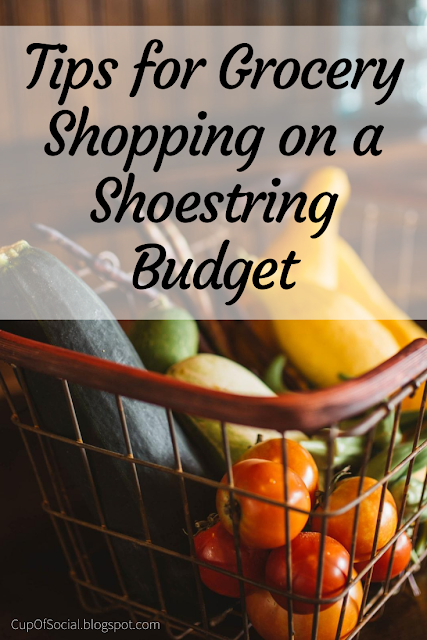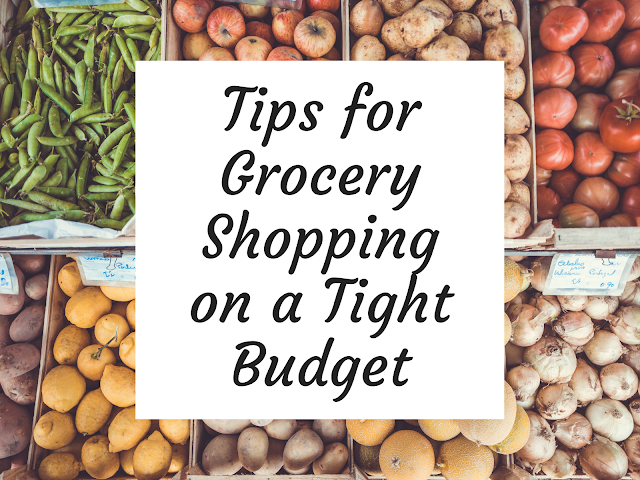Tips for Grocery Shopping on a Shoestring Budget
Every day people struggle with putting food on the table. It's not uncommon to work full time at a minimum wage job and make too much to qualify for food stamps but not make enough to feed yourself and family. And let's not even get into food deserts where you only have access to dollar stores for any groceries (check out this heartbreaking article on that topic) and while they seem like cheaper options, you actually pay more in the long run due to tiny sizes or lots of filler ingredients.
As someone who has had to cut their grocery budget to almost nothing in the past, I've learned the hard way how to maximize my grocery budget without skipping too much on nutrition. I've used budget food boxes from church programs, I've shopped food "thrift" stores, I've used point and rebate apps for extra food money, and I've turned every food scrap into a new meal in every way possible. Ten years ago, my monthly bills left me $10 in red every month before food and gas and I relied on my parents for grocery and gas money (and I am grateful every day for every last cent they have ever given me).
And thanks to my parents, green thumb and my husband's knack for finding things to sell/flip in our home quickly, I've never had to wonder if we could make it to payday before having to go grocery shopping again. But I see plenty of people on Twitter, Facebook and Reddit asking exactly how to do stretch their tiny budget or how to save money on groceries. So I compiled my list of first-hand shoestring grocery budget tips.
For more budget information, check out my other budget posts.
As someone who has had to cut their grocery budget to almost nothing in the past, I've learned the hard way how to maximize my grocery budget without skipping too much on nutrition. I've used budget food boxes from church programs, I've shopped food "thrift" stores, I've used point and rebate apps for extra food money, and I've turned every food scrap into a new meal in every way possible. Ten years ago, my monthly bills left me $10 in red every month before food and gas and I relied on my parents for grocery and gas money (and I am grateful every day for every last cent they have ever given me).
And thanks to my parents, green thumb and my husband's knack for finding things to sell/flip in our home quickly, I've never had to wonder if we could make it to payday before having to go grocery shopping again. But I see plenty of people on Twitter, Facebook and Reddit asking exactly how to do stretch their tiny budget or how to save money on groceries. So I compiled my list of first-hand shoestring grocery budget tips.
For more budget information, check out my other budget posts.
Tips for Grocery Shopping on a Shoestring Budget
- Whenever possible know what stores in your area have the cheapest prices. Aldi is comparable but I don't like their canned veggies, so I only buy things I know are a good value and that I like the taste of (like their steak sauce and gluten free mac & cheese).
- If your local stores have grocery apps, use them to plan your budget as you can see in store prices. I've seen people on Reddit suggest using Instacart for this but in-store prices can vary from Instacart.
- Use coupons and sales only on things you need, don't buy something simply because you are "saving money" if you will not use it or if it requires you to pay more than you normally would (ie name brand canned veggies are on sale 2/$1 vs store brand that is regularly $0.45 each).
- If you cook bacon, save the grease in a sealed jar and keep it in your fridge. Use that for added fat and flavor.
- If a tiny budget is not a temporary thing but a prolonged budget, swap out similarly priced produce, beans, proteins, and grains to switch up nutrients, especially if a multivitamin can't be afforded.
- Waste nothing! Eat or freeze all leftovers. Potato skins can be turned into chips. Veggie and meat scraps can be added to a canned broth or water to make more flavorful. Some vegetables and herbs can be regrown or rooted for continued use.
- Put any budget leftover into a pantry stockpile, to bulk up meals/add extras or save for a later week when money may be extra tight. (More on stockpiles here.)
- Learn to make from scratch when it's cheaper to do so and buy prepared/ready made/instant when it's not.
- Learn how to turn single products into multiple (ie oats can be used to make milk and flour in addition to oatmeal).
- Use things like QuickRewards.net (learn more here) and Ibotta (referral link) to add extra money to food budget.
- Budget per item to maximize your budget. Know what you are willing to pay per item helps cut costs and finds extra room in your budget as well as making it easy to ask a shopping buddy to grab items for you.
- If you always grab impulse buys, consider curbside pickup if you are buying enough to meet the minimum purchase (in my area, it's a $30 minimum for Walmart pick up) or only using cash to pay for your purchase.
- Use any extra budget room for flavor enhancement! Sauces, salsa and spices can all be picked up for $1 or less.
- If you can't afford spices, buy pre-flavored ingredients. Canned tomatoes often cost the same (aside from fire roasted) for plain, Italian style, garlic & olive oil, green pepper & celery, and chili flavored. This also goes for beans and canned veggies. Take the flavor where you can!
- If you only have a tiny bit of something left but not enough for a second serving, use it to flavor the next meal or freeze it for use later on. A spoonful of leftover pasta sauce adds some flavor to otherwise plain, boring rice.
- Sprout beans for added nutrition, especially if you have to skip on produce in any form.
- Pinto beans are slightly cheaper at my Walmart than lentils and are larger, so you feel like you are eating more. However, they require overnight soaking and take longer to cook, so decide if you want bulk or quick cooking when purchasing.
- Overcooking rice in extra liquid helps increase the volume but can make it mushy. Choose wisely if attempting this to bulk up a meal.
- Speaking of which, at my Walmart brown rice and white rice cost the same amount but brown is more filling and flavorful so I always opt for brown rice if it's available.
- Likewise sweet potatoes and russet potatoes are the same price for 5 pounds.
- Skip soda and opt for water, black coffee, tea, Kool-Aid, or infused water.
- And on that note - If you can't afford coffee or tea, leftover herbs, spices or fruit peels can be added to water for an infused "tea." Additionally, while bland and of zero nutritional value, sipping a mug of hot/warm water can keep you full during the day, help fill you up after a lighter meal and in general keep you warm feeling and aid in digestion vs cold water. Because I run cold, I switched from my usual room temp water to hot water during the day. It was hot water or constant cups of coffee. My waistline (I do NOT drink it black, I like my life full of sweetness) and budget have appreciated this swap. I can attest that it not only keeps me warm but has stopped mindless snacking.
- Whenever possible work in extras into your grocery budget to fill it out. $2 for a jar of cheap peanut butter can go a long way for adding something extra to your day and caloric intake.
Until next time my lovelies!
-M
Check out more Home Life posts like this.
 |
| Pin Now for Later! |


